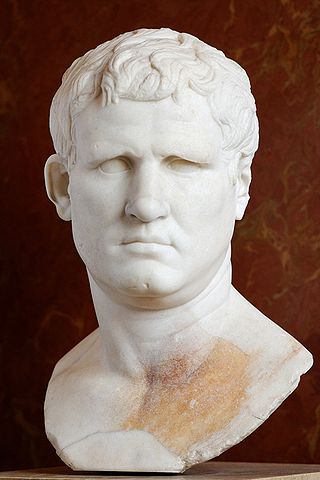Related Research Articles

Marcus Vipsanius Agrippa was a Roman general, statesman, and architect who was a close friend, son-in-law, and lieutenant to the Roman emperor Augustus. He was responsible for the construction of some of the most notable buildings in history, including the original Pantheon, and is well known for his important military victories, notably the Battle of Actium in 31 BC against the forces of Mark Antony and Cleopatra.
This article concerns the period 19 BC – 10 BC.
Agrippina is an ancient Roman cognomen and a feminine given name. People with either the cognomen or the given name include:

Publius Quinctilius Varus was a Roman general and politician under the first Roman emperor Augustus. Varus is generally remembered for having lost three Roman legions when ambushed by Germanic tribes led by Arminius in the Battle of the Teutoburg Forest, whereupon he killed himself.
Decimus Junius Silanus Torquatus was a Roman senator who lived during the 1st century.

Vipsania Agrippina was the first wife of the Emperor Tiberius. She was the daughter of Marcus Vipsanius Agrippa and Pomponia Caecilia Attica, thus a granddaughter of Titus Pomponius Atticus, the best friend of Cicero.
Attica was the daughter of Cicero's Epicurean friend Titus Pomponius Atticus. She was also the first wife of Marcus Vipsanius Agrippa, close friend of the emperor Augustus.
Claudia Marcella was the name of several women of ancient Rome of the Marcelli branch of the Claudia gens. By the late Republican period girls from this branch were often called "Clodia".
Marcus Aemilius Lepidus was a patrician Roman senator, politician and general, praised by the historian Tacitus.
Quintus Haterius Antoninus or known as Antoninus was a Roman senator, who was active during the reign of Claudius and Nero.
Vipsania Polla was an ancient Roman woman of the late Republic, she was the sister of emperor Augustus' right hand man Marcus Vipsanius Agrippa. She is best known today for the construction of the Porticus Vipsania.
Claudia Marcella Major (PIR2 C 1102; born some time before 40 BC) was the senior niece of Roman emperor Augustus, being the eldest daughter of his sister Octavia the Younger and her first husband Gaius Claudius Marcellus. She became the second wife of Augustus' foremost general Marcus Vipsanius Agrippa and after that the wife of Iullus Antonius, the son of Mark Antony.
Iulla Antonia or Antonia Iulla is thought to be a daughter of Roman consul of 10 BCE Iullus Antonius and Claudia Marcella Major. The only direct evidence of her existence that has been found is a funerary urn.
Sextus Nonius Quinctilianus was a Roman Senator. He was appointed consul in AD 8 as the colleague of Marcus Furius Camillus.
Claudia Pulchra (14 BC – AD 26) (PIR2 C 1116) was a Patrician woman of Ancient Rome who lived during the reigns of the Roman emperors Augustus and Tiberius.

The gens Vipsania or Vipsana was an obscure plebeian family of equestrian rank at ancient Rome. Few members of this gens appear in history, although a number are known from inscriptions. By far the most illustrious of the family was Marcus Vipsanius Agrippa, a close friend and adviser of Augustus, whom the emperor intended to make his heir. After Agrippa died, Augustus adopted his friend's sons, each of whom was considered a possible heir to the Empire, but when each of them died or proved unsuitable, Augustus chose another heir, the future emperor Tiberius.
Vipsania was an ancient Roman noblewoman of the first century BC. She was married to the politician Publius Quinctilius Varus and was a daughter of Roman general Marcus Vipsanius Agrippa and his second wife Claudia Marcella Major.
Vipsania was an ancient Roman noblewoman of the first century BC. She was married to the politician Marcus Aemilius Lepidus and was likely the daughter of Roman general Marcus Vipsanius Agrippa and his second wife Claudia Marcella Major.
Vipsania was an ancient Roman noblewoman of the first century BC. She was married to the orator Quintus Haterius and was likely the daughter of Roman general Marcus Vipsanius Agrippa and his first wife Pomponia Caecilia Attica.
Vipsania was the name of the first wife of Roman emperor Tiberius.
References
- ↑ Suet., Aug. 63.1.
- ↑ Powell, Lindsay (2015). Marcus Agrippa: Right-Hand Man of Caesar Augustus. Pen and Sword. ISBN 9781473853812.
- ↑ Meyer Reinhold, "M. Agrippa's Son-in-Law P. Quinctilius Varus," CPh 67 (1972), 119–21).
- ↑ R. Syme, The Augustan Aristocracy, Oxford, 1986, p. 125.
- ↑ Syme, Ronald (1989). The Augustan Aristocracy (illustrated and revised ed.). Clarendon Press. p. 145. ISBN 9780198147312.
- ↑ American Journal of Ancient History. Vol. 1–4. 1976. p. 140.
- ↑ Knopf, Franziska (2012). Die Ehepolitik des Augustus (Octavian): Eine Untersuchung zu den Eheschließungen innerhalb der "domus Augusta". Tectum Wissenschaftsverlag. p. 87. ISBN 9783828855403.
- ↑ Nogueira, Adeilson (2020). Gens Nas Moedas Romanas. Clube de Autores.